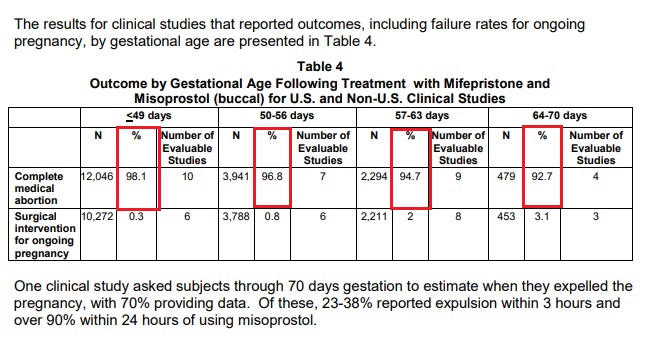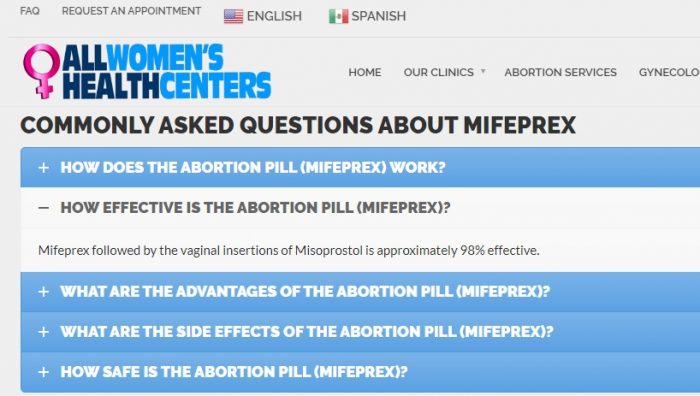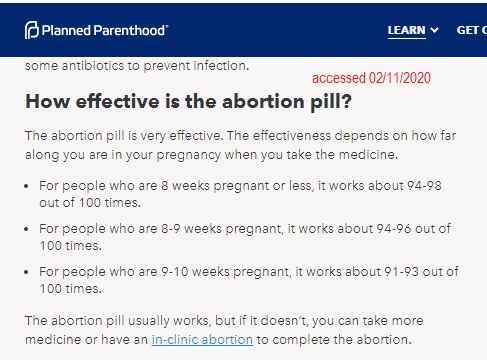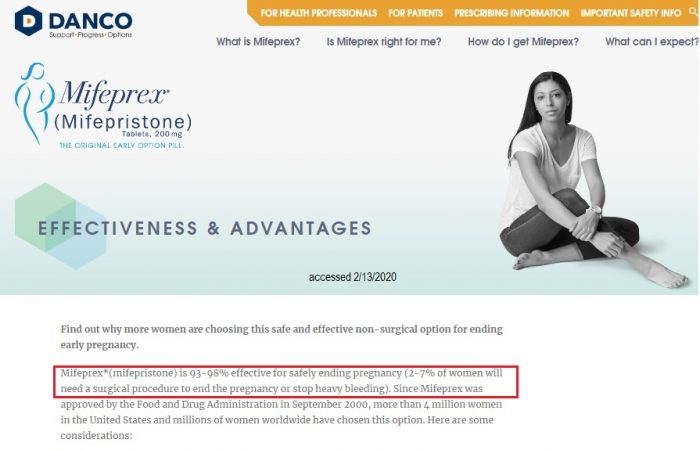The abortion pill is frequently marketed to women as a simple, more private method of abortion, similar to a miscarriage. Planned Parenthood says the abortion pill is “a safe and effective way to end an early pregnancy” which is “kind of like having a really heavy, crampy period.” While Live Action News has discussed the fact that it isn’t as safe as some make it out to be, and that numerous women have had horrifying experiences with the abortion pill, what’s not often discussed is the fact that it is often far less than “effective.” Thousands of women could potentially be in need of emergency care or a second abortion when the abortion pill fails.
Abortion advocates are pushing “self-managed” abortion as safe and simple, yet their own statistics reveal that the abortion pill regimen fails between 7,000 to 24,000 times annually — or even as high as 31,000 times a year. This means women could potentially need a second (surgical) abortion. Currently, an FDA safety system known as REMS requires prescribers of the abortion pill to accurately determine the correct gestational age of the preborn baby, detect an ectopic pregnancy if one exists, and have a means to provide emergency care to patients. In many cases, the abortion facility will require the woman to return to verify that the abortion was complete. If abortion advocates succeed in getting the FDA to do away with REMS, abortion advocates will shift that responsibility to the woman or teen girl, many of whom may be unaware that their abortions were incomplete. This is potentially life threatening.
The abortion pill regimen consists of two pills: Mifeprex (regulated under the REMS system) and Misoprostol. The regimen is approved for use through 70 days (10 weeks) of pregnancy. The FDA’s 2019 label for Mifeprex makes it clear that the failure rate increases as the gestational age advances.

FDA Mifeprex 2019 label abortion pill and failure rate
How many abortions are done via the abortion pill annually?
Planned Parenthood’s former research arm and “special affiliate,” the Guttmacher Institute, reports that the abortion pill currently accounts for nearly 40 percent (39%) of reported abortions in the United states. According to their data, in 2017 there were 339,640 medication abortions committed nationally out of 862,320 total reported.
What is the failure rate of the abortion pill?
Live Action News reviewed several abortion facility websites and found a variety of answers:
Claim of 95% effective/5% failure rate:
- In 2019, the Guttmacher Institute claimed, “Medication abortion is highly effective, with a success rate of more than 95% [5% failure rate] using the standard protocol.”
- Women’s Health Specialists of California
- All Women’s Health Centers

All Womens Health Centers on abortion pill and failure rate
Claim of 98% effective/2% failure rate:
- Southwestern Women’s abortion.
- My Choice Medical Center.
- Carefem, which is taking part in the TelAbortion clinical trial.
Claim of 95-98% effective/2 to 5% failure rate:
Camelback Family Planning: “Mifeprex… is 95-98% effective…. If the pregnancy tissue has not passed, you might need a D&C or to repeat the Misoprostol.”
Claim of 96-98% effective/2-4% failure rate:
West Alabama Women’s Center: “There is a 96-98% chance the medications will be successful in bringing on an abortion.”Asked how the patient will know the abortion is complete, the clinic advises, “The only way to be certain that the abortion is over is to come back to the clinic for your follow-up visit.” They add, “The embryo is usually a small amount of white tissue, and sometimes it is inside a blood clot. Even if you see it close up, it doesn’t look like a baby…. However, the further along in the pregnancy the greater the chances are of seeing fetal parts.”
What about gestational age?
According to a Planned Parenthood document as well as current online information for patients, failure rates for the abortion pill vary by gestational age:
- 8 weeks or less- 94% to 98% effective/2 to 6% failure rate.
- 8 to 9 weeks – 94 to 96% effective/4 to 6% failure rate.
- 9 to 10 weeks – 91-93% effective/7 to 9% failure rate.

Image: Planned Parenthood abortion pill and failure rate accessed 02112020
What does the manufacturer claim?
DANCO Laboratories’ website reads, “Mifeprex*(mifepristone) is 93-98% effective for safely ending pregnancy (2-7% of women will need a surgical procedure to end the pregnancy or stop heavy bleeding).” DANCO cites this same statistic in an online pamphlet.

Danco on Mifeprex abortion pill failure rate and effectiveness
GenBioPro is the company that makes the generic version of Mifeprex, (approved in 2019). Their online pamphlet states, “Every year in the United States, more than 200,000 women manage their unwanted pregnancy through medical abortion…. 2-7%—will need a follow-up surgical procedure to end their pregnancy or to stop too much bleeding.”
Based on this, how many chemical abortions fail annually?
- Using the 200,000 number from GenBioPro as a base total, this translates into 4,000 to 14,000 abortion pill patients who run the risk of needing a second, more invasive surgical abortion.
- Using Guttmacher’s 2017 total of 339,640 chemical abortions as a base along with failure rates of 2% to 7% noted by the manufacturer, we calculate a range between 7,000 and 24,000.
- Using Planned Parenthood’s percentage range (2% to 9%) against 339,640, we calculate that abortion pill failures could affect 7,000 to 31,000 women annually.
Warnings:
Little Rock Family Planning abortion facility warns patients that they should not obtain a medication abortion if, “You cannot easily get emergency medical help should a problem occur.”
Northland Family Planning abortion facility warns that, “A medical abortion has a slightly higher failure rate than surgical abortion….” The facility calls the purchase of abortion pills online “dangerous,” writing:
We know that more women are attempting to buy pills online to end their pregnancies; however, when you buy pills from the Internet you do not know what you are really getting. While rare, if you experience an ectopic pregnancy (a pregnancy in which the fertilized egg implants outside the uterus) and it is not properly diagnosed and treated by a physician, it could be life threatening….The abortion pill, prescribed by a physician, is a safe way to have a self-managed abortion at home. It is in your best interest to be seen by a physician who is an expert in abortion care.
Shockingly, this late-term abortion facility in Florida advises women, “It is possible up to 4, 5, 6 or 7 months or further to undergo a medical chemical abortion procedure.”
Pro-abortion ER Doctor Dara Kass pointed out, “Recently published results of the Gynuity pilot project showed that 8 percent of their patients who received abortion medication sought follow-up care at a local urgent care clinic or emergency department.” Using the 339,640 (and growing) annual number and we estimate that 27,000 women could report to an emergency department after a “self-managed” abortion every single year.
In 2018, the FDA updated its adverse effects reports on legally dispensed abortion pills, revealing 24 deaths of women associated with the abortion pill since its approval. The report documents that abortion pills have caused nearly 4,200 reported adverse effects, including 1,042 hospitalizations, nearly 600 instances of blood loss requiring transfusions, and other serious complications. But under 2016 changes, abortion pill manufacturer DANCO no longer has to report non-fatal adverse effects, so we have no way of knowing what the number really is.
Editor’s Note, 4/18/21: The FDA has received reports of serious adverse events in women who took Mifeprex. As of December 31, 2018, there were reports of 24 deaths of women associated with Mifeprex since the product was approved in September 2000, including two cases of ectopic pregnancy resulting in death; and several cases of severe systemic infection (also called sepsis), including some that were fatal.
The adverse events cannot with certainty be causally attributed to mifepristone because of concurrent use of other drugs, other medical or surgical treatments, co-existing medical conditions, and information gaps about patient health status and clinical management of the patient. A summary report of adverse events that reflects data through December 31, 2018 is here.
“Like” Live Action News on Facebook for more pro-life news and commentary!







